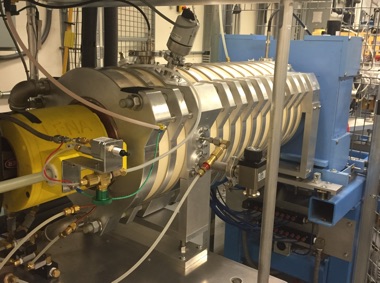UNC NUCLEAR ASTROPHYSICS
Department of Physics & Astronomy
Laboratory for Experimental Nuclear Astrophysics
UNC NUCLEAR ASTROPHYSICS
Department of Physics & Astronomy
Laboratory for Experimental Nuclear Astrophysics


FACILITIES
LENA: THE HIGHEST PROTON BEAM INTENSITY LOW-ENERGY
ACCELERATOR IN THE WORLD
LENA DETECTORS
The main detection device at LENA is the gamma-ray coincidence spectrometer, shown on the right. It consists of a 140% HPGe detector (yellow), placed in close geometry to the target. Both the HPGe detector and the target are surrounded by a NaI(Tl) scintillator annulus, which is made up of 16 optically isolated segments. The idea behind this device is that in most fusion reactions of astrophysical interest, the nucleus is created in an excited state at an energy of several MeV or more. In the majority of cases, the nucleus de-excites via emission of more than one photon (i.e., giving rise to a gamma-ray cascade). Detecting the photons belonging to a given cascade in time-coincidence, and imposing, in addition, energy requirements (for example, by setting coincidence gates in a 2-dimensional histogram of NaI(Tl) energy versus HPGe energy) greatly reduces the environmental background and improves the detection sensitivity significantly. This improvement in sensitivity is crucial for measuring weak cross sections or yields of astrophysically important reactions. This technique was first described in Rowland et al., NIM A480, 610 (2002) and the spectrometer is characterized in Longland et al., NIM A566, 452 (2006) and Howard et al., NIM A729, 254 (2013). The first authors are our former graduate students and postdocs.


LENA is noted internationally for its precision nuclear reaction rate measurements of rare astrophysical processes, which are critical to stellar nucleosynthesis. Creating stellar conditions at LENA requires very intense beams and highly selective detection techniques. The acceleration system at LENA has already produced proton currents on target up to 2.5 mA, the most intense beams worldwide in any laboratory where such studies are underway. We are now in the process of commissioning an improved acceleration column capable of accelerating 30 mA of protons to energies up to 240 keV. The new column is depicted on the left between the yellow solenoidal magnet around the ion source and the blue solenoidal magnetic lens used to focus the emerging proton beam toward the target. Both the ion source and new column were designed and constructed locally, using precision parts fabricated in our departmental instrument shop at UNC-CH. Three axial insulating rods are used to support the column and compress O-ring vacuum seals between its electrodes and ceramic insulators. Internal transverse magnetic fields along the entire column length suppress backstreaming electrons which had previously produced dangerous levels of bremsstrahlung X-rays. Two channels of chilled flowing deionized water along the column now provide simultaneously both a high resistance path for column current to establish the uniform acceleration field gradient, and active cooling for the intervening column electrodes.